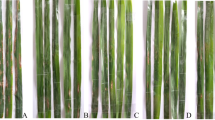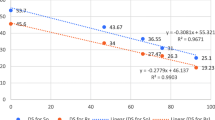Abstract
In this study, 87 Trichoderma strains were isolated from healthy rice seeds of the cultivar RD59 and subsequently screened for their antagonistic activities against various rice pathogens using dual culture methods. Out of these, 12 strains exhibited strong antagonistic properties and were further selected for a detailed assessment of their fungicidal effects in controlling rice seed rot and false smut diseases under both laboratory and field conditions. Notably, among the evaluated Trichoderma strains, T. harzianum KUFA 0741, applied to RD59 rice seeds, was found to be the most effective in enhancing root length and shoot height, with increases of 9.73 cm and 29.04 cm, respectively. In contrast, T. asperellum KUFA 0733 significantly improved rice germination, achieving a 95% success rate. Furthermore, T. harzianum KUFA 0741 also demonstrated a pronounced biocontrol effect by reducing the incidence of seedling rot by 39.24%, closely followed by T. asperellum KUFA 0733 and T. harzianum KUFA 0740, which reduced the disease incidence by 37.78% and 34.8%, respectively. In terms of managing rice false smut disease, treatment with T. harzianum KUFA 0740 was observed to be highly effective, significantly reducing disease occurrence in both the panicle and seed by 54.24% and 82.23%, respectively. Additionally, it contributed to an increase in rice yield, reaching 1,571 kg per acre, in contrast to the 1, 241 kg per acre yield observed in the control treatment. The antagonistic activities of these Trichoderma strains appear to be linked to their ability to stimulate rice growth and compete for natural resources effectively. They also displayed compatibility with the fungicide hexaconazole. The outcomes of this study indicate that T. harzianum KUFA 0741 and KUFA 0740 have been validated as potent biocontrol agents against rice seedling rot and false smut diseases and can be combined with compatible fungicides, enabling their use in integrated disease management approaches.




Similar content being viewed by others
References
Ahuja, R., Sidhu, A., & Bala, A. (2020). Manganese sulfide nanospheres as mycocidal material and priming agent for fungi-infested rice seeds. Journal of Phytopathology, 168(11–12), 678–687.
Anhar, A., Putri, D. H., Advinda, L., Atika, V., Amimi, S., Aldo, W., & Ruchi, W. (2021). Molecular characterization of Trichoderma strains from West Sumatera, Indonesia and their beneficial effects on rice seedling growth. Journal of Crop Science and Biotechnology, 24(4), 441–448.
Baite, M. S., Prabhukarthikeyan, S. R., & Raghu, S. (2022). Biological control of a fungus Ustilaginoidea virens causing false smut of rice. BioControl, 67(3), 357–363.
Behera, H. T., Mojumdar, A., Behera, S. S., Das, S., & Ray, L. (2022). Biocontrol of wilt disease of rice seedlings incited by Fusarium oxysporum through soil application of Streptomyces chilikensis RC1830. Letters in Applied Microbiology, 75(5), 1366–1382.
Chou, C., Castilla, N., Hadi, B., Tanaka, T., Chiba, S., & Sato, I. (2020). Rice blast management in Cambodian rice fields using Trichoderma harzianum and a resistant variety. Crop Protection, 135, 104864.
Chung, E. J., Hossain, M. T., Khan, A., Kim, K. H., Jeon, C. O., & Chung, Y. R. (2015). Bacillus oryzicola sp. Nov., an endophytic bacterium isolated from the roots of rice with antimicrobial, plant growth promoting, and systemic resistance inducing activities in rice. Plant Pathology Journal, 31(2), 152–164.
Collinge, D. B., Jensen, B., & Jørgensen, H. J. (2022). Fungal endophytes in plants and their relationship to plant disease. Current Opinion in Microbiology, 69, 102177.
Das, S., Kundu, S., Meena, K., Jha, R. K., Varma, A., Bahuguna, R. N., & Tripathi, S. (2023). Seed biopriming with potential bioagents influences physiological processes and plant defense enzymes to ameliorate sheath blight induced yield loss in rice (Oryza sativa L.). World Journal of Microbiology and Biotechnology, 39(5), 136.
Dethoup, T., Kaewsalong, N., Songkumorn, P., & Jantasorn, A. (2018). Potential of a marine-derived species, Talaromyces tratensis KUFA 0091 against rice diseases. Biological Control, 119, 1–6.
Dethoup, T., Jantasorn, A., & Kaewsalong, N. (2022a). Efficacy of the antagonistic fungus Talaromyces tratensis KUFA 0091 in controlling rice blast and brown leaf spot diseases in field trials. Agriculture and Natural Resources, 56(4), 697–704.
Dethoup, T., Klaram, R., Pankaew, T., & Jantasorn, A. (2022b). Impact of fungicides and plant extracts on biocontrol agents and side-effects of Trichoderma spp. on rice growth. European Journal of Plant Pathology, 164(4), 567–582.
Hagh-Doust, N., Färkkilä, S. M. A., Hosseyni Moghaddam, M. S., & Tedersoo, L. (2022). Symbiotic fungi as biotechnological tools: Methodological challenges and relative benefits in agriculture and forestry. Fungal Biology Reviews, 42, 34–55.
Haque, Z., & Khan, M. R. (2023). Optimization of different application methods of multi-facial bacterial and fungal antagonists against sheath blight pathogen of rice, Rhizoctonia solani AG1-IA. Journal of Phytopathology, 171(1), 23–35.
Hu, X., Wang, J., Zhang, Y., Wu, X., Li, R., & Li, M. (2023). Visualization of the entire process of rice spikelet infection by Ustilaginoidea virens through nondestructive inoculation. Frontiers in Microbiology, 14, 1228597.
Jiehua, Q., Shuai, M., Yizhen, D., Shiwen, H., & Yanjun, K. (2019). Ustilaginoidea virens: A fungus infects rice flower and threats world rice production. Rice Science, 26(4), 199–206.
Kaewsalong, N., Songkumarn, P., Duangmal, K., & Dethoup, T. (2019). Synergistic effects of combinations of novel strains of Trichoderma species and Coscinium fenestratum extract in controlling rice dirty panicle. Journal of Plant Pathology, 101(2), 367–372.
Khanal, S., Gaire, S. P., & Zhou, X.-G. (2023). Kernel smut and false smut: The old-emerging diseases of rice-a review. Phytopathology, 113(6), 931–944.
Khepar, V., Sidhu, A., Sharma, A. B., & Sharma, P. (2023). Zinc sulfide nano aqua formulation as antifungal nanopriming agent against phytopathogens of paddy seeds: In silico, in vitro and seed treatment studies. European Journal of Plant Pathology, 165(3), 509–524.
Klaram, R., Jantasorn, A., & Dethoup, T. (2022). Efficacy of marine antagonist, Trichoderma spp. as halo-tolerant biofungicide in controlling rice diseases and yield improvement. Biological Control, 172, 104985.
Leon, V. C., Raja, M., Pandian, R. T. P., Kumar, A., & Sharma, P. (2018). Opportunistic endophytism of Trichoderma species in rice Pusa Basmati-1 (PB1). Indian Journal of Experimental Biology, 56(2), 121–128.
Lian, H., Li, R., Ma, G., Zhao, Z., Zhang, T., & Li, M. (2023). The effect of Trichoderma harzianum agents on physiological-biochemical characteristics of cucumber and the control effect against Fusarium wilt. Scientific Reports, 13(1), 17606.
Limdolthamand, S., Songkumarn, P., Suwannarat, S., Jantasorn, A., & Dethoup, T. (2023). Biocontrol efficacy of endophytic Trichoderma spp. in fresh and dry powder formulations in controlling northern corn leaf blight in sweet corn. Biological Control, 181, 105217.
Liu, L., Zhao, K., Cai, L., Zhang, Y., Fu, Q., & Huang, S. (2023). Combination effects of tebuconazole with Bacillus subtilis to control rice false smut and the related synergistic mechanism. Pest Management Science, 79(1), 234–243.
Mahmud, H., Rahman, M. S., Akter, M. F., Umara, U., & Hossain, I. (2023). Study on financial assessment of rice production causing false smut disease of different varieties at farm level in Kushtia district. Archives of Phytopathology and Plant Protection, 56(12), 919–941.
Mohd Anuar, I. S., Ku Sulong, K. A., Abdul Ghani, H., & Wahab, M. Z. (2020). Alginate encapsulation of Trichoderma harzianum against brown spot disease on rice (Oryzae sativa) in vivo assays. Food Research, 4, 138–141.
Pablo, C. H. D., Pagaduan, J. R. R., Langres, H. K. C., & Hipol, R. M. (2020). Plant growth-promoting characteristics of root fungal endophytes isolated from a traditional cordillera rice landrace. Studies in Fungi, 5(1), 536–549.
Pastor, N., Palacios, S., & Torres, A. M. (2023). Microbial consortia containing fungal biocontrol agents, with emphasis on Trichoderma spp.: current applications for plant protection and effects on soil microbial communities. European Journal of Plant Pathology, 167(4), 593–620.
Paul, M. K., Mini, K. D., & Mathew, J. (2022). Antifungal effects of Kurthia gibsonii Mb 126 chitinase as a seed treatment on seed-borne fungi of rice seed on germination percentage and seedling vigor. Journal of Applied Biology and Biotechnology, 10(4), 130–135.
Saldaña-Mendoza, S. A., Pacios-Michelena, S., Palacios-Ponce, A. S., Chávez-González, M. L., & Aguilar, C. N. (2023). Trichoderma as a biological control agent: Mechanisms of action, benefits for crops and development of formulations. World Journal of Microbiology and Biotechnology, 39(10), 269.
Sharma, A., Gupta, B., Verma, S., Pal, J., Mukesh, A., & Chauhan, P. (2023). Unveiling the biocontrol potential of Trichoderma. European Journal of Plant Pathology, 167(4), 569–591.
Song, J.-H., Zhang, S. J., Wang, Y., Wang, Y., Chen, Y.-T., Luo, J. F., Liang, Y., Zhang, H.-C., Dai, Q.-G., Xu, K., & Huo, Z.-Y. (2022a). Baseline sensitivity and control efficacy of two quinone outside inhibitor fungicides, azoxystrobin and pyraclostrobin, against Ustilaginoidea virens. Plant Disease, 106(11), 2967–2973.
Song, J., Wang, Z., Wang, Y., Zhang, S., Lei, T., Liang, Y., Dai, Q., Huo, Z., Xu, K., & Chen, S. (2022b). Prevalence of carbendazin resistance in field populations of the rice false smut pathogen Ustilaginoidea virens from Jiangsu, China, molecular mechanisms, and fitness stability. Journal of Fungi, 8(12), 1311.
Swain, H., Adak, T., Mukherjee, A. K., Sarangi, S., Samal, P., Khandual, A., Jena, R., Bhattacharyya, P., Naik, S. K., Mehetre, S. T., Baite, M. S., Kumar, S., & Zaidi, N. W. (2021). Seed biopriming with Trichoderma strains isolated from tree bark improves plant growth, antioxidative defense system in rice and enhance straw degradation capacity. Frontiers in Microbiology, 12, 633881.
Verma, S. K., Kingsley, K. L., Bergen, M. S., Kowalski, K. P., & White, J. F. (2018). Fungal disease prevention in seedlings of rice (Oryza sativa) and other grasses by growth-promoting seed-associated endophytic bacteria from invasive Phragmites australis. Microorganisms, 6(1), 21.
Vijitrpanth, A., Jantasorn, A., & Dethoup, T. (2023). Potential and fungicidal compatibility of antagonist endophytic Trichoderma spp. from rice leaves in controlling dirty panicle disease in intensive rice farming. BioControl, 68(1), 61–73.
Xiao, Z., Zhao, Q., Li, W., Gao, L., & Liu, G. (2023). Strain improvement of Trichoderma harzianum for enhanced biocontrol capacity: Strategies and prospects. Frontiers in Microbiology, 14, 1146210.
Zhou, Y., Yu, J., Pan, X., Song, J.-H., Zhang, S.-J., Wang, Y., Chen, Y.-T., Luo, J.-F., Liang, Y., Zhang, H.-C., Dai, Q.-G., Xu, K., Zhong-Yang Huo, Z.-Y., Yin, X., & Liu, Y. (2019). Characterization of propiconazole field-resistant isolates of Ustilaginoidea virens. Pesticide Biochemistry and Physiology, 153, 144–151.
Acknowledgements
This work was financially supported by National Research Council of Thailand (NRCT), grant no. N41A640083.
Author information
Authors and Affiliations
Corresponding author
Ethics declarations
Conflict of interest
The authors declare no conflict of interest.
Ethics approval
This article does not contain any studies with human participants or animals performed by any of the authors.
Rights and permissions
Springer Nature or its licensor (e.g. a society or other partner) holds exclusive rights to this article under a publishing agreement with the author(s) or other rightsholder(s); author self-archiving of the accepted manuscript version of this article is solely governed by the terms of such publishing agreement and applicable law.
About this article
Cite this article
Seekham, N., Kaewsalong, N. & Dethoup, T. Efficacy of Trichoderma obtained from healthy rice seeds in promoting seedling growth and controlling rice seed rot and false smut diseases under field conditions. Eur J Plant Pathol (2024). https://doi.org/10.1007/s10658-024-02852-x
Accepted:
Published:
DOI: https://doi.org/10.1007/s10658-024-02852-x




